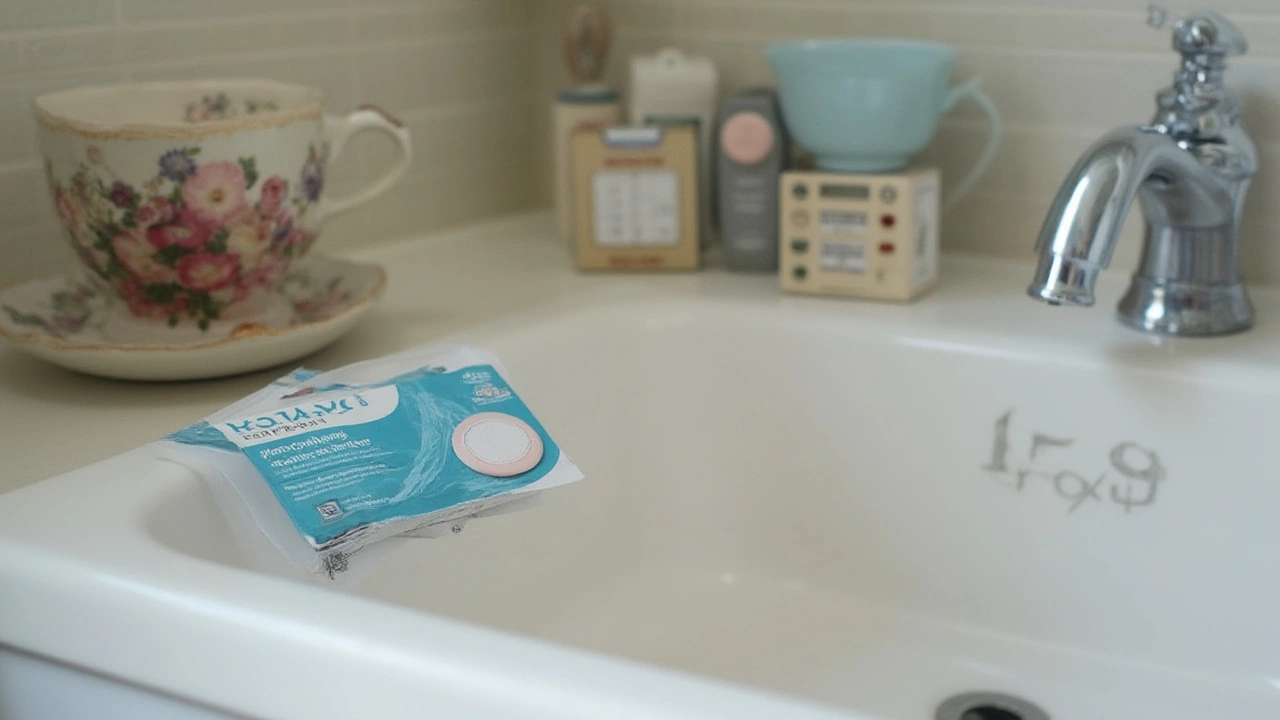Imagine you’re in a movie theater, the film’s at its most suspenseful moment, and your bladder decides the show’s over. If that sounds familiar, you’re not alone. Overactive bladder can hijack daily routines in the most inconvenient ways. Enter Oxytrol — a discreet, medicated patch designed to keep your bladder from running the show. What sets it apart from pills? The patch releases medication slowly through your skin, offering a steady effect without the pill juggling.
What is Oxytrol and How Does It Work?
Oxytrol, with the active ingredient oxybutynin, flips the script for those dealing with the constant urge to pee. The science is pretty cool: it’s an anticholinergic, which means it blocks some of the nerve signals that trigger sudden muscle contractions in the bladder. Less urgency, fewer sprints to the bathroom. This prescription patch sits quietly on your skin while it gets to work, and it’s the only oxybutynin product you can buy without a prescription in the U.S. — but just for women. Men still need a doctor’s note. Why? Because symptoms can sometimes point to other health issues in men that need special attention.
The patch itself isn’t science fiction, but it feels like something out of a spy movie: you wear it on your abdomen, hips, or buttocks, and swap it out twice a week. It sticks around for about four days at a time. Many find this whole setup a relief compared to the daily pill grind. Studies published in the "Journal of Urology" show the patch keeps oxybutynin levels steadier in your blood, cutting the highest peaks that cause dry mouth, the classic side effect.
| Oxytrol Patch Facts | Details |
|---|---|
| Active Ingredient | Oxybutynin |
| Dose | 3.9 mg/day |
| How Often to Change | Every 4 days |
| Available without Prescription | For women (U.S. only) |
| Main Use | Overactive Bladder |
| Common Side Effects | Skin irritation, dry mouth, constipation |
An overactive bladder affects about 16% of adults in the U.S. People often wait years before seeking treatment, not realizing products like Oxytrol could help. The steady delivery through the skin means the medication bypasses the digestive system, which is great if pills make you queasy or you’re keeping count of too many tablets. Convenience matters: you only have to remember to switch the patch a couple times a week, rather than fiddling with bottles every day.
So, is Oxytrol for everyone? Not quite. It’s best for women over 18 who have tried other self-help steps like bladder retraining but still spend more time mapping out bathrooms than enjoying life. The patch shouldn’t be used if there’s trouble emptying your bladder, or by anyone with certain digestive conditions — always check the label and talk to a pharmacist or your doc if in doubt. Side note: Oxytrol isn’t the go-to for sudden-onset bladder issues, which might mean something more serious is up.
Folks want to know if it works fast. The patch doesn’t offer magic overnight fixes. Most people see improvement within a week or two, with study participants peeing less often and feeling more in control. The difference isn’t just on the toilet — better sleep, fewer embarrassing accidents, and less travel anxiety is a win in anyone’s book.
A cool tip from users: if you notice redness or itchiness after patch removal, rotate the application site. Skin needs a break to avoid irritation, and a little fragrance-free moisturizer helps soothe the spot afterward (just make sure it’s not greasy or it’ll mess with the patch sticking next time).

Living with Oxytrol: Tips, Myths, and Daily Experiences
People have questions — lots of them. Does the patch show through clothes? Not really; it’s thin and unremarkable once on. Can you shower or swim with it? Go ahead. The adhesive is strong enough for showers and moderate swimming, but hardcore laps might challenge its stickiness. Pat the patch dry if it gets wet, and avoid lotions or oils around the patch area, or it might slide off.
One thing most folks don’t realize: you can wear Oxytrol patches on your belly, hips, or buttocks — just not the same spot twice in a row. Switch things up for your skin's sake. And don’t sweat about hairy spots; just trim, not shave, before applying the patch for the best grip.
Another burning question: Will I lose hair where I stick the patch? Occasional users have noticed some temporary hair thinning at the site, but it’s rare. The bigger complaint is mild skin itching or a red rash if you’re sensitive. If you’re seeing angry welts, let your doctor know. Sometimes it’s an allergy, more often it’s just annoyed skin.
What about interactions? Oxytrol’s active ingredient, oxybutynin, can interact with antihistamines, some heart meds, other anticholinergic drugs, and even certain antidepressants. If you’re juggling medications, always check for updates with your pharmacist — things like grapefruit juice don’t mess with Oxytrol, but double-duty on the same type of drug can up your risk of classic side effects: dry mouth, constipation, heat sensitivity. Here’s a pro tip: keeping sugar-free gum or hard candy handy melts dry mouth in minutes, and staying hydrated keeps constipation in check.
- To apply, stick Oxytrol to clean, dry, hairless skin — no lotions or powders. Press down for 10 seconds.
- Rotate the application site each time. Never stick to broken or irritated skin.
- If a patch falls off, just stick on a new one and go back to your usual swap-out schedule.
- Keep up with daily pelvic floor exercises if your doctor advises — the patch helps, but muscles matter, too.
There’s a rumor Oxytrol is just for “little old ladies” — but overactive bladder hits all ages. It’s common in women post-childbirth, people with diabetes, or anyone whose bathroom radar is too active. Easing urgency isn’t just about comfort. Nighttime bathroom runs increase fall risk, especially for seniors. Young mothers report reclaiming their sleep and not planning outings around restroom maps.
If you find Oxytrol patches falling off early (sweaty workouts, summer heat), reach for a medical tape (think paper tape, not duct tape) to lightly secure the edges. Just don’t cover the entire patch. Let it breathe.
Sometimes, people worry about privacy: will my partner notice? Only if they’re eagle-eyed. The patch hides under underwear and even swimsuits without a fuss. No one has to know unless you want to share.
For travel, Oxytrol gives one less pill bottle to pack and less worry about missed doses in different time zones. Just change your patch as usual and move on. And yes, TSA can see it on the scanner — but it’s no big deal. Agents are used to patches, insulin pumps, and other medical devices.

Side Effects, When to Call the Doctor, and What to Expect Long-Term
No patch is perfect, and Oxytrol has its fair share of side effects. Most are mild: dry mouth, mild constipation, a bit of blurry vision, or red patches on the skin. About 16% of users in trials experienced skin irritation — something to watch for if you’re sensitive. Drink plenty of water, eat fiber-rich foods (hello, apples and oatmeal), and don’t be a stranger to the moisturizer aisle.
Other potential side effects worth knowing about: dizziness, drowsiness, and trouble focusing your eyes. If you plan on driving or working with heavy machinery, take note of how your body reacts before diving in. Rarely, if you have serious trouble urinating, high fever, confusion, or new irregular heartbeat, stop using the patch and see your doctor right away. Side effects leading to stopping the patch are uncommon, but always watch for red flag symptoms.
Many users report that bothersome dry mouth usually goes away after a few weeks, once your body gets used to the steady medication level. Some find sipping iced water or chewing sugar-free gum helps. On the upside, about half of people using Oxytrol experience fewer urinary leaks and sudden urges based on data from post-marketing surveillance studies. Actual results vary, but most folks live with fewer disruptions and less anxiety about losing control in public.
Curious about long-term use? Oxytrol can be worn for months or even years if it keeps working and side effects are manageable. Talk to a healthcare provider every year to check in about heart health, kidney function, and any new symptoms, especially if you add other medications.
One piece of advice for anyone starting: keep a bladder diary before and after you begin. Counting the number of daytime pees, nighttime bathroom trips, and leaks per week helps you measure if the patch is worth your investment — and gives your doc vital information to adjust your treatment if needed.
For those after non-drug strategies too, simple steps go a long way. Watch caffeine and alcohol, especially late in the day. Strengthening your pelvic floor doesn’t require expensive gear — apps and YouTube tutorials can guide you through Kegels at home. Scheduling bathroom breaks (“bladder training”) plus the patch can boost confidence.
Lastly, toss those “one-size-fits-all” expectations. Listen to your body, rotate your patches, keep extra medical tape for emergencies, and stay in touch with your pharmacist if you’re unsure about interactions. The biggest win? Getting back to your movie, concert, or family outing without the bathroom ruling your every move. That’s a small patch for a pretty big payoff.

